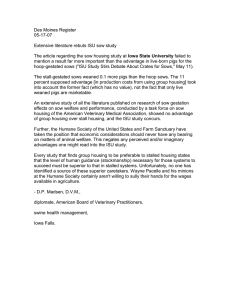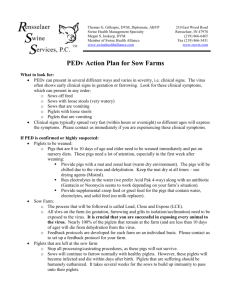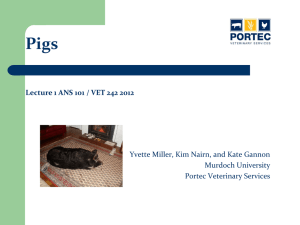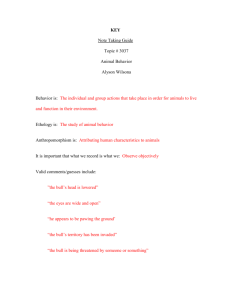Colin Johnson, of the Iowa Pork Industry Center
advertisement
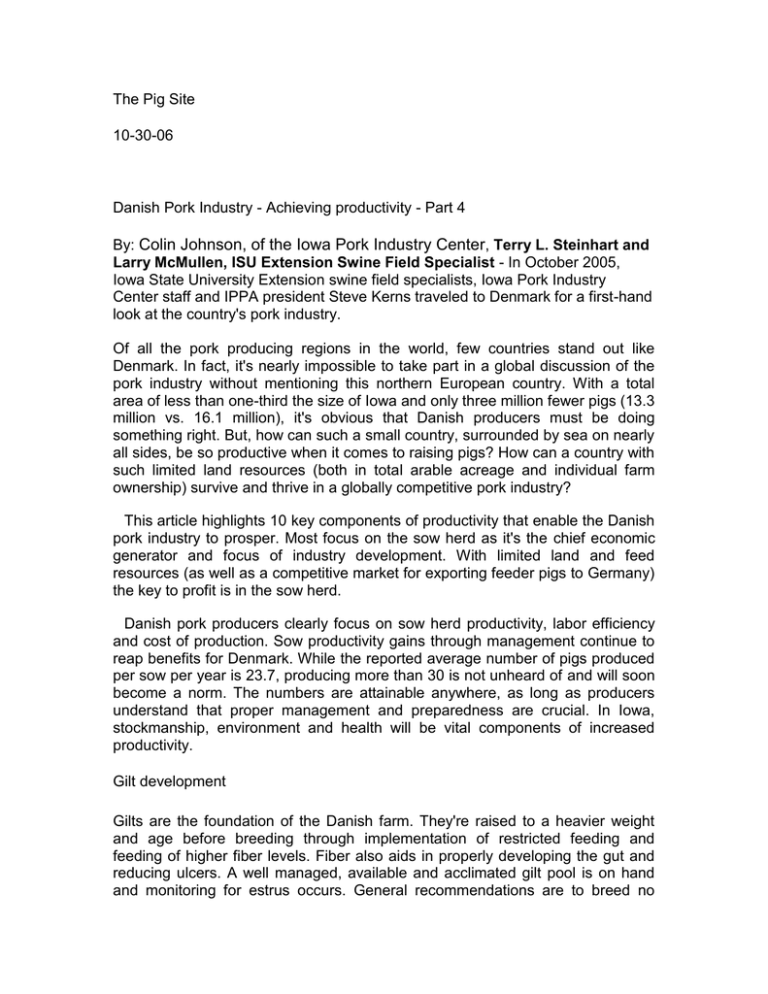
The Pig Site 10-30-06 Danish Pork Industry - Achieving productivity - Part 4 By: Colin Johnson, of the Iowa Pork Industry Center, Terry L. Steinhart and Larry McMullen, ISU Extension Swine Field Specialist - In October 2005, Iowa State University Extension swine field specialists, Iowa Pork Industry Center staff and IPPA president Steve Kerns traveled to Denmark for a first-hand look at the country's pork industry. Of all the pork producing regions in the world, few countries stand out like Denmark. In fact, it's nearly impossible to take part in a global discussion of the pork industry without mentioning this northern European country. With a total area of less than one-third the size of Iowa and only three million fewer pigs (13.3 million vs. 16.1 million), it's obvious that Danish producers must be doing something right. But, how can such a small country, surrounded by sea on nearly all sides, be so productive when it comes to raising pigs? How can a country with such limited land resources (both in total arable acreage and individual farm ownership) survive and thrive in a globally competitive pork industry? This article highlights 10 key components of productivity that enable the Danish pork industry to prosper. Most focus on the sow herd as it's the chief economic generator and focus of industry development. With limited land and feed resources (as well as a competitive market for exporting feeder pigs to Germany) the key to profit is in the sow herd. Danish pork producers clearly focus on sow herd productivity, labor efficiency and cost of production. Sow productivity gains through management continue to reap benefits for Denmark. While the reported average number of pigs produced per sow per year is 23.7, producing more than 30 is not unheard of and will soon become a norm. The numbers are attainable anywhere, as long as producers understand that proper management and preparedness are crucial. In Iowa, stockmanship, environment and health will be vital components of increased productivity. Gilt development Gilts are the foundation of the Danish farm. They're raised to a heavier weight and age before breeding through implementation of restricted feeding and feeding of higher fiber levels. Fiber also aids in properly developing the gut and reducing ulcers. A well managed, available and acclimated gilt pool is on hand and monitoring for estrus occurs. General recommendations are to breed no sooner than 290 lbs. and eight months of age; but some farms aim to breed at 350 lbs. and nine months of age. Strict control of estrus triggering and weight gain must be practiced to meet these targets. This entails limited movement and mixing during the grow out and development period. However, for purposes of potential litter size, these targets achieve the highest productivity. Gilt development and first parity gestation costs represent a significant investment. Employee participation Danish farms have a highly trained staff with an advanced degree of husbandry skills. Danish farmers are required to have various levels of formal "farmer" education. For example: a person cannot own or manage a farm without completing the college education and receiving the "green certificate." Employees are treated well and are a valued part of the farm; their decisionmaking input is valued. Together, individual employees and the farmer set goals and maintain a focus to achieve them as a team. They have a high degree of job satisfaction and enjoy being a part of the team. Employees have specific roles within the farm, but maintain an understanding of the whole; i.e., the impacts of weaning weights on the cost of production, finishing herd health and performance, and total farm throughput. Employees are "pig-specific" and do not have roles elsewhere, such as field work. The farm owner and/or manager must be a leader and be interested in what their employees do, both on and off the farm. Workers must be motivated and made to feel as part of the team. The culture exists where employees are like family. Another great feature is the availability of a support agency with access to a network of temporary labor that's trained in the industry. This reduces downtime and loss in herd performance when a key employee or owner is away due to illness, vacation, etc. This is a frequent issue as the Danes receive approximately 42 days of vacation annually. Nurse sows The national average for live born per litter in 2004 was 12.9. The top 25% of herds averaged 13.4. The number of pigs produced per sow per year averaged 23.7. When Danish production numbers for pigs per sow per year are reported, it's important to note that those numbers are of pigs raised to 30 kg (66 lbs) through the nursery phase. This is very noteworthy as it represents truly healthy and productive pigs weaned and reared through the nursery. High numbers born live mean more sows are required to nurse piglets. Because of minimal disease pressures on a farm and a degree of continuous flow farrowing rooms, weaned sows are kept to nurse a second fostered litter. Younger (parity one or two) sows often are kept for the extended nursing due to condition, teat quality and reproductive advantages realized beyond parity two. Caution must be exercised for selection of a nurse sow in good body condition, nursing a heavy litter and consuming feed well. The extended lactation period can be hard on maintaining body condition and subsequent rebreeding. There are two practices for creating nurse sows and litters: one-step and two-step. (It's important to recognize that the average weaning age is four weeks.) A one-step nurse sow is created by weaning piglets from a sow after at least 21 days of age (by Danish law). It must be a good sized litter with sow and piglets in good condition. The sow is moved either to a newly created litter of excess piglets (big piglets more than six hrs. after birth) where she is called a one-step nurse sow, or to a litter of 4-7 days of age where she is called an intermediate sow. The sow (parity one or two) providing the 4-7 day-old piglets is then moved to a crate where excess newborn piglets have been collected and she becomes a two-step nurse sow. The best practice is the two-step nurse sow and movement of the sow, not the litter. Two-step sows more readily accept the new piglets resulting in lower mortality than a one-step nurse or having no nurse sows. Many dynamics exist in a practice with high born alive numbers and use of nurse sows. However, even with the increased complexity of creating and managing nurse sows and litters, the reality is that more pigs are weaned at heavier weights, which creates higher survivability post weaning and reduced diet costs. While labor requirements in farrowing might increase, the breeding and gestation costs per weaned pig are lower. The other paradigm change is that this practice requires empty farrowing crates; not loading the farrowing barn full. If the average live born number is 12.9 and the desired litter size to nurse is 12, this demands approximately 7.5% more farrowing spaces. Theoretically, for every 13 sows farrowed, one crate is left empty for space to create a nurse sow and litter. Experience groups The openness and transparency of Danish farmers certainly ensures their success. A very clear communication channel exists among farmers. Arising from the cooperative spirit that rings throughout Danish culture, farmers are selforganized to share ideas, records and results of test trials. From agronomic plot demonstrations to open houses for new livestock barns, neighboring farmers and the community all gain a better understanding of modern production tools. Some regional groups are organized by industry advisors specific to a particular theme. Some groups may be employees who work with a particular task within the farm; i.e., breeding technicians, while other groups could be local farmers discussing the economy of the farm in general. As a whole, these cooperative conversations and sharing activities lead to healthy competition and the survival of the most efficient production systems. Genetic progress There has been consistent progress in born alive selection within the Danish breeding program. The national average in 2004 was 12.9 live born per litter. A new breeding objective introduced in nucleus herds in 2001 was number of live piglets per litter at five days post-farrow (LP5). The new selection criterion ensures size and livability of piglets in the litter. A high number of born alive increases potential for numbers weaned and throughput. This is a valid genetic component as evidenced by the fact that more than 95% of farms utilize the national breeding program. Quality matings Consistent timing of heat checks and breeding is practiced. Every farm has a standard operating procedure in place for mating practices. Gilts/sows are not artificially induced to estrus. A 5-point breeding scheme adapted from Norway ensures a high degree of controlled boar exposure and heat checking. There is an active, engaged mating process and artificial insemination gets physical. As the breeder, one must simulate the effects of the boar including back and side pressure and vocalization. There is firm heat and boar presence is controlled. A "surprise effect" of boar exposure ensures a high degree of sows bred by 7 days. The "surprise effect" entails the following practice: day 1 (weaning) through day 3: 24 hr. continual boar contact; day 4: no boar contact (24 hr. before breeding); days 5-7: short-term boar contact (heat check) and breed within 20 minutes. Percent bred by 7 days and percent farrowed is critical in any operation, and in Denmark, there is a focus on doing it right the first time. Much of this detail draws from the owner/operator's vested interest in the farm as well as reliance on highly trained, highly skilled and proven employees. Use of advisors Available, well-trained swine specialists are routinely engaged on farms for technical advice in areas such as pig flow, facility design, labor management, finance, feeding and nutrition, breeding, welfare assessment, etc. These specialists also provide and analyze production and efficiency reports. Other specialists are employed in crops, environment, economy, etc. Advising centers are owned and governed by farmers. The individual farmer pays an annual fee to be a member of the regional advisory system and also pays hourly fees for any work on behalf of the farmer, either on the farm or off the farm, including travel. Veterinarians, regulated to visiting the farm at least one time per month, also confer with the farm's advisors. Weaning age The minimum weaning age is 28 days; the national reported average is 31. [With nurse sows, the original litter is not reported until the 2nd litter is weaned.] Increasing weaning age has helped to ensure the sow's return to a proper metabolic and reproductive state for preparation of estrus and successful breeding. Lactating sows are fed ad lib and farrowing rooms are managed for sow comfort in order to drive intake and maintain body condition. The microenvironment for the litter is created by in-floor heating, heat lamps and hovers. Older weaning ages also result in heavier pigs capable of a healthier start in the nursery phase. Unlike in the United States, blood plasma and meal may not be used in feeds, thus early weaning is more difficult than for American farmers. Weaning age should be well controlled with minimal age fluctuations within a weaning group. Tight weaning ages minimize disease pressures and breaks in immunity. With the use of nurse sows, diligence is necessary to avoid "leaking" pigs of varying age across weaning groups. Farmers watch the carryover of older pigs or weaning of heavier pigs that are big enough, yet not old enough. If farrowing management personnel is not consistent, the system will be flawed. Animal movement A practice of limited movement and effective handling exists. Sows are not moved or mixed during critical times of embryo implantation and periods affecting reproductive efficiency. While more than 60% of sows are currently gestated in group housing, most are bred in stalls and remain there for four weeks prior to mixing. This helps to ensure embryonic attachment and survival. Stress at feeding time is reduced by the use of electronic feeding stations or feeding stalls in a variety of designs. Sorting for pregnancy checks, vaccination and farrowing can be managed through the electronic feeding stations. Pig environment The sea climate in Denmark is milder than in the Midwest with fewer fluctuations in temperature extremes. This allows for a more consistent temperature within the barns and reduces the need for constant changes in ventilation rate and type. More importantly, it reduces the possibilities for management errors in adjusting the barn environment. Quiet ventilation systems operate with efficient exchange of air, and drafts are minimized. There is minimal seasonal infertility, in contrast to our low summer breeding due to Midwest heat. Natural light is allowed in the barns and sow housing and breeding areas are well lit with clean, artificial light. A good environment in the barn creates a good environment for both pigs and people. The attitude of employees goes a long way in impacting the performance of the animals. A word to Iowa None of these should be new concepts to Iowa farmers. Whether one is farrowing or finishing, the common interest of increasing productivity - or pounds weaned - from the sow farm should be evident. Heavier weaning weights reduce feed costs, mortality and days to market. More pigs weaned should drive down the cost per pig. Individual farm goals will differ, but a review of best management practices and corresponding determination to be the best often can guide producers to better numbers and a better bottom line. For more information, contact the Iowa Pork Industry Center (800-808-7675) or any ISU Extension swine/livestock field specialist. Field specialists are available to present information on the Danish pork industry or the specific issues of productivity, antibiotic growth promotants, and animal welfare.
